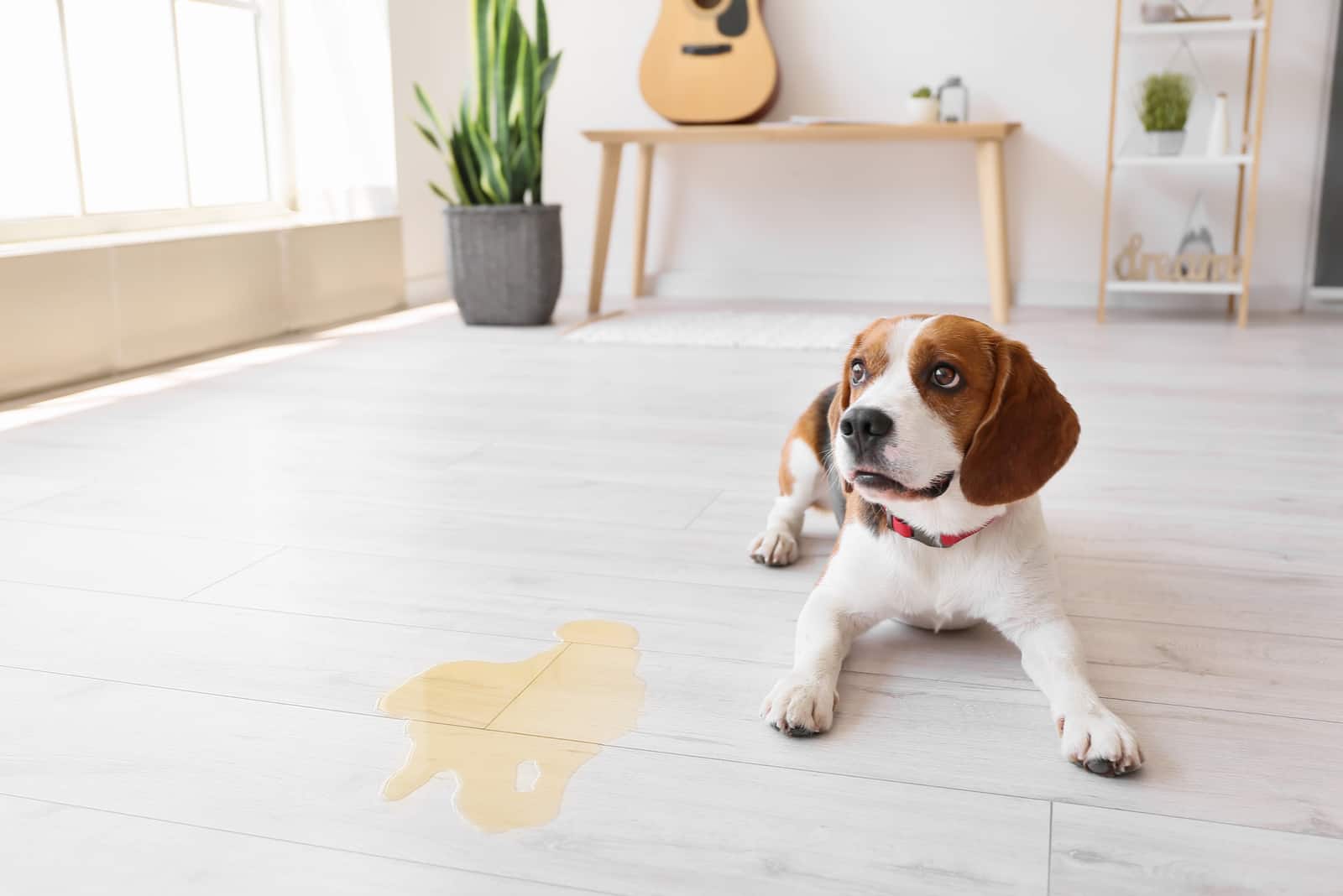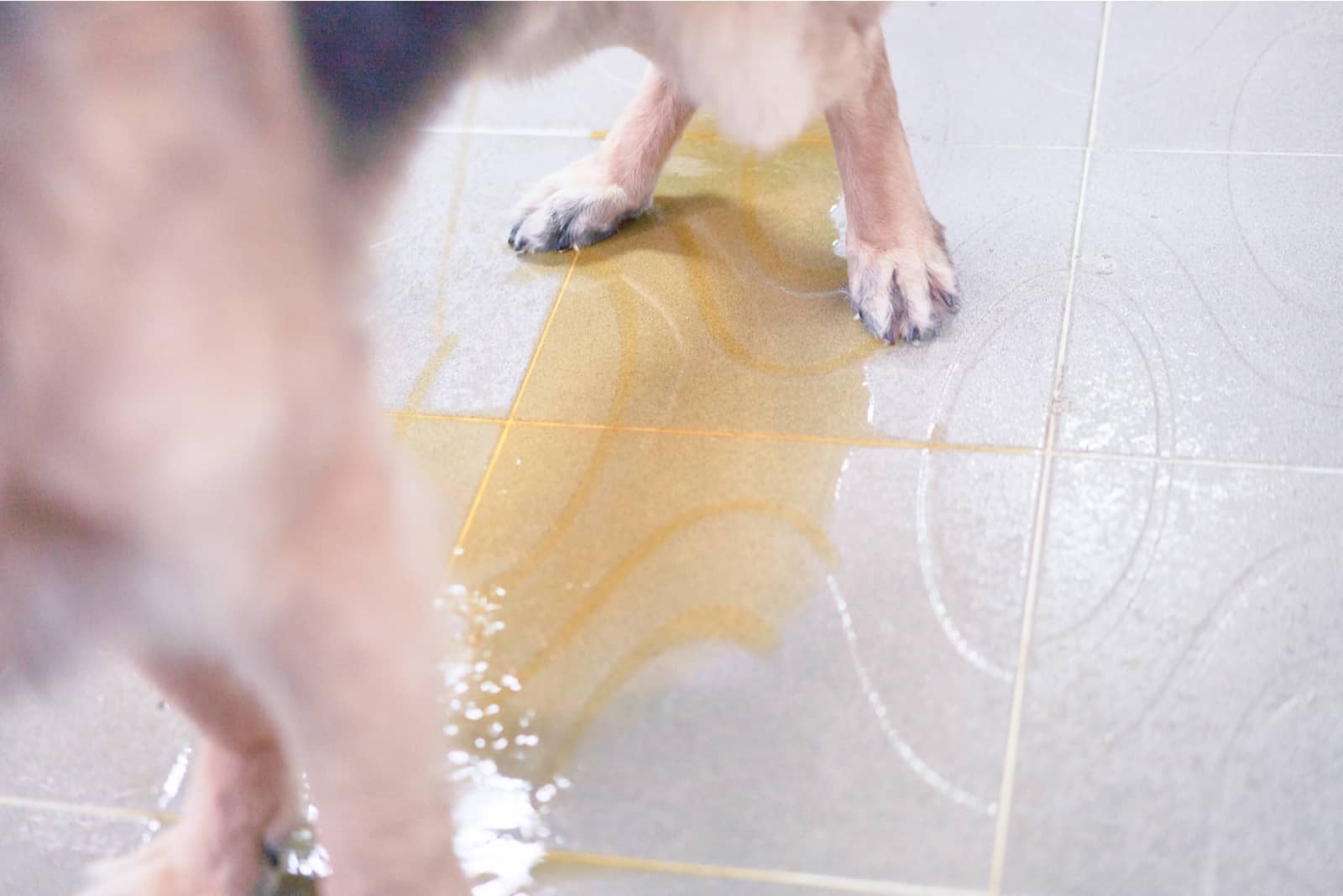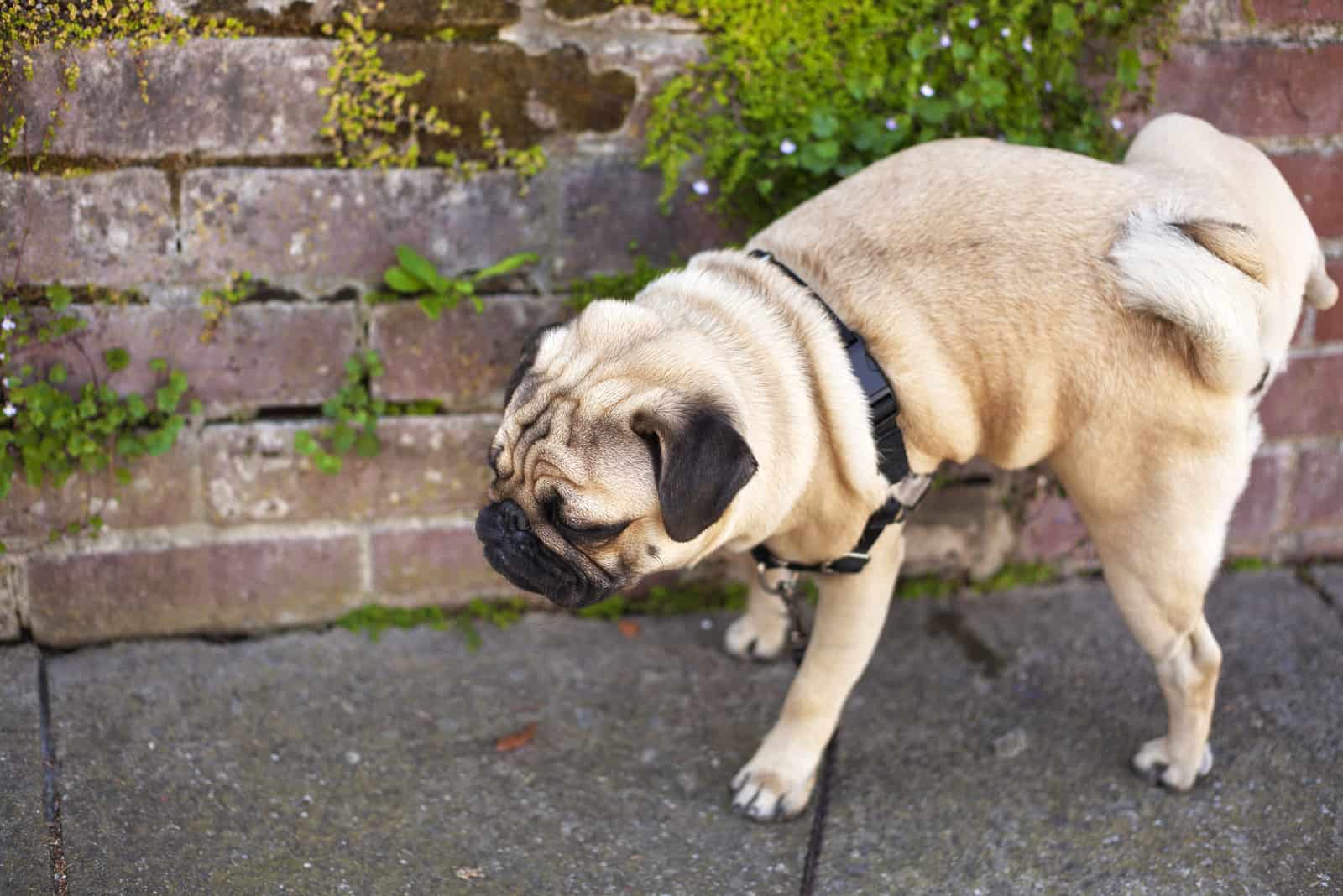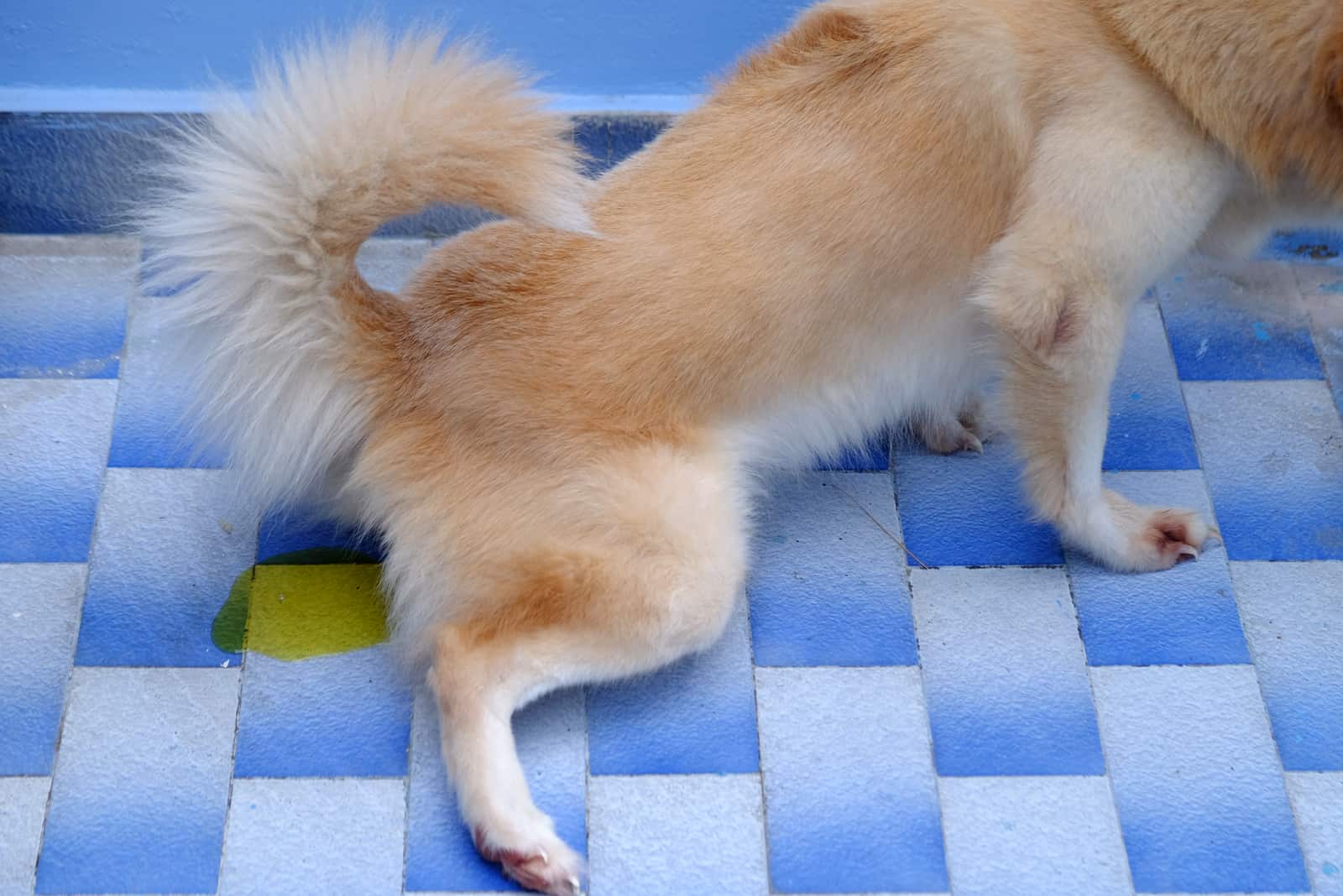If your dog is feeling blue, and you just can’t seem to figure out what could be wrong, it’s time you check your dog’s pee.
A dog’s urine is an important indicator of a dog’s health. A change in your dog’s urine color might suggest some underlying health issues.
A dog urine color chart is a simple tool that many dog owners find useful in determining their overall dog health.
So, “what are the possible colors of dog urine?”
To put it simply, a dog’s urine colors range from transparent to black. Each color of urine either shows your dog’s hydration or an underlying medical condition.
Today, we are going to talk about a lot of medical conditions that are linked to your dog’s pee. Following this dog urine color chart will help you figure out if your dog is having any health-related problems.
Let’s check out the normal and abnormal dog urine colors.
Dog Urine Color Chart – An Overview
This dog urine color chart shows what kind of colors your dog’s urine might get. Notice how it starts with the transparent, and finishes with the darkest urine color.
Dog urine colors are placed in order from the least “serious” ones, to those that indicate serious medical conditions.
Here are the possible dog urine colors.
| Urine Color | Indication | What Should I Do? |
|---|---|---|
| Transparent | Overhydration | Monitor. Decrease water intake |
| Pale/Light yellow | Normal | Nothing. Everything’s okay |
| Bright Yellow | Lightly Dehydrated | Monitor. Increase water intake |
| Dark Yellow | Dehydrated, Kidney Issues | Visit the vet. Increase water intake |
| Orange | Jaundice, Liver Failure | Immediately visit the vet |
| Red/Pink | Renal Issues, Inflammation | Immediately visit the vet |
| Green | Diet, Kidney Issues | Immediately visit the vet |
| Brown/Black | Internal Bleeding, Inflammation, Toxins | Immediately visit the vet |
What Color Should My Dog’s Urine Be?
Your dog’s urine is supposed to be pale yellow. Now, due to the fact that many people see colors differently, it’s hard to accurately describe the shade of yellow. But, we will try to!
Normally, a dog’s urine color shouldn’t be transparent. In fact, it should be a transparent yellow. Therefore, a normal dog’s pee color ranges from a pale to light-yellow color.
Besides color, a healthy dog’s pee should always be a clear liquid (without any floating particles). Anything out of the ordinary is considered pathological.
Is it normal for a dog’s urine to be yellow?
A healthy dog’s urine color should always be pale yellow.
But, if it starts turning to a darker yellow color, or it completely changes color, then it might be time to visit the vet and seek advice.
What Does My Dog’s Pee Color Mean?
Your dog’s pee color can tell you a lot about its health.
Although your dog’s urine color changes all through the day, it should never change to different colors. Pee colors such as brown, green, or red, most likely indicate health problems.
But, your dog’s pee color doesn’t always have to indicate health issues.
Imagine that your dog’s pee color is a presentation of its hydration state – a “hydration-meter”. In other words, the dog’s pee color will vary depending on your dog’s water intake. The more water it drinks, the clearer the urine will be.
However, too much of anything isn’t good for anyone — and so isn’t too much water intake for your dog.
Let’s see what happens when your dog’s urine turns a different color.
Dog’s Pee Color Insight

The changes in a dog’s pee color can be linked to various medical conditions. Some urine colors require immediate veterinary care, whereas some can be monitored by the dog owner.
In any case, you should know what kind of dog pee colors indicate that it’s time to visit your veterinarian.
We will now describe each dog urine color and explain what it might mean for your dog’s health.
Transparent Dog Urine Color
Transparent or clear urine can be seen in dogs that might have drank one too many water bowls. Overhydration happens when your dog takes in too much water – the opposite of dehydration.
Luckily, overhydration isn’t as dangerous as dehydration. What overhydration does to a dog’s body is that it dilutes the urine and blood consistency.
By diluting the blood consistency, water can interfere with the stability and distribution of electrolytes and other chemical compounds. This can lead to a chemical imbalance and problems with blood pressure.
Moreover, red blood cells can become overhydrated. This can lead to higher blood volume, which can potentially lead to kidney problems.
Although it sounds harmless, overhydration can be deadly.
In the worst case scenario, overhydration can lead to tissue swelling, diarrhea, seizures, vomiting, and coma.
Bright Yellow And Light Yellow Dog Urine Color
Pale to light yellow urine color in dogs is normal. Such shade of yellow indicates that your dog is well hydrated — not too much and not too little.
Normal dog urine color shades can vary depending on diet, water intake, and exercise. It’s important to know that a dog’s pee color normally changes throughout the day.
It can also change if there are some ingredients present in food that tend to alter the color of urine. Such food includes beetroot, brussel sprouts, asparagus, broccoli, carrots, etc.
That said, you will want to pay attention to what you’re feeding your dog. It’s best to avoid certain human foods as they can be very toxic to our beloved furballs.
Dark Yellow Dog Urine Color

Remember the hydration meter? Well, when the normal light-yellow color of urine changes to dark-yellow urine, that is usually due to dehydration. What this means is that your dog most likely hasn’t been drinking enough water during the day. If you have noticed that your dog’s urine has turned dark yellow, and then turned normal by the next time it peed, then you shouldn’t worry too much.
Dehydration can be temporary. But, it can also be a very serious medical condition. Dehydration is sometimes the only visible clinical sign of a serious illness.
So, it’s best to get your dog checked if you notice that it’s dehydrated even when it regularly drinks water.
Sometimes, dark yellow urine is followed by a strong smell. This smell is caused by urea, a chemical compound produced by the liver. In the worst case, dark yellow dog pee can be linked to liver and kidney diseases.
Orange Dog Urine Color
Orange color of urine can be either a shade of dark yellow, or a deep orange color. So, what causes orange dog urine color?
As much as I hate to say this, the orange color of urine indicates certain health problems in dogs. Unlike the colors we mentioned before, orange urine mostly requires a vet check-up.
Orange urine is often seen in dogs that suffer from chronic liver diseases, as well as problems with their pancreas and gallbladder.
Orange urine in dogs is a specific sign of jaundice, and it can also be a sign of severe dehydration.
Red Or Pink Dog Urine Color
The presence of red urine color is a red flag.
The proper medical term for red urine is “hematuria”, which literally means blood in urine. So, should you worry if you notice that your dog pees red urine?
Well, we strongly advise you to take your dog to the vet as soon as possible. When your dog pees red, this can be a clinical sign of an acute urinary tract infection.
Red urine can also be seen in dogs suffering from Babesiosis. This acute medical condition, known as “Red water”, is a result of a tick bite. I cannot stress enough how serious this life-threatening health problem is. Babesiosis requires immediate veterinary care.
Red urine in dogs can also be a sign of chronic medical conditions such as tumors, kidney failure, and liver disease.
Green Dog Urine Color

Your dog’s pee can turn green due to chronic gallbladder and liver diseases or acute urinary tract infections. Green urine is most likely a sign of hemolytic anemia. This health condition is quite common in dogs. Hemolytic anemia means the destruction of red blood cells. Hemolysis (the breakdown of red blood cells) produces a greenish pigment that later colors your dog’s pee.
But, green urine in dogs can appear from their diet. Sometimes, a more plant-based diet is to blame for a dog’s pee turning green. So, green vegetables like broccoli, brussel sprouts, artichokes, and asparagus might cause your dog to pee green urine.
Nevertheless, the green color of urine is a signal to take your dog to the vet because it may show that something’s wrong with your dog’s health.
Brown Or Black Dog Urine Color
In all seriousness, if you see your dog peeing black or brown urine, it’s time to immediately take it to the vet.
Red blood cell damage causes the brown color of urine in dogs. If red blood cells are damaged, they will release a chemical compound called hemoglobin. Hemoglobin is brown in color, and it is very important in the blood-oxygen supply.
In other words, blood that is present in the urinary system causes your dog’s pee to turn brown, or in some cases — black.
Brown color of urine is usually a sign of serious acute conditions such as poisonings, internal organ damage, severe dehydration, muscle damage, and urinary tract infections.
Every form of muscle damage includes the release of myoglobin, which can color your dog’s pee in dark red or dark brown.
Brown pee in dogs can also be a sign of a past chronic medical condition; for example, when your dog has suffered from kidney stones, chronic kidney infections, tumors, or gallbladder infections.
These kinds of medical conditions damage the urinary tract and cause bleeding. Blood can accumulate within the urinary system during an illness, and be released upon recovery.
Dog’s Pee Viscosity

A dog’s pee color is not the only thing that matters when evaluating a dog’s health. A dog’s pee viscosity is an important indicator of potential underlying, acute or chronic medical conditions.
A change in a dog’s pee color doesn’t have to always follow a change in a dog’s pee viscosity.
A dog’s pee viscosity can change due to medical conditions that interfere with chemical compounds within the body.
But, if you notice that your dog’s urine is odd — smelly, thick, slimy, or cloudy, it’s time to check what’s up.
Why Is My Dog’s Pee Thick?
Thick urine in dogs can be a result of many different things, and it doesn’t necessarily mean a serious medical condition.
When female dogs are in heat, their pee viscosity can change due to the mucus present around the vagina.
During peeing, this mucus mixes with pee and forms a thick urine. In male dogs, sperm can cause a thick urine consistency during the mating period.
Lipids can be normally found in a dog’s urine, but they do not present serious medical conditions. These are droplets of fat that are common in a dog’s pee.
Additionally, when the color of urine changes, along with its viscosity, this might indicate serious medical conditions like kidney failure, liver diseases, and even heart problems.
Sticky Urine In Dogs
Sticky dog urine is linked to diabetes. And, here’s why.
Diabetes Mellitus causes excess sugar in your dog’s pee. The sugar produced by the body is called glucose.
Glucosuria is a medical way of saying “glucose in a dog’s urine”. And, well, we know that sugar can become sticky when in a liquid state.
Glucose shouldn’t be normally present in your dog’s pee. So, if glucose is found after a urinalysis, your vet might want to run some health tests.
Cloudy Dog Pee
Cloudy dog urine usually indicates the presence of pus. This condition is called pyuria. Cloudy dog pee can be linked to acute urinary tract infections and kidney diseases.
Cloudy, dark-yellow urine might also indicate dehydration. Other medical conditions include kidney stones and crystals.
Mucus In A Dog’s Pee
As we mentioned before, mucus in a female dog’s pee can be due to her heat cycle. That is something you don’t have to worry about.
Besides that, mucus in a dog’s pee can be a sign of acute gallbladder or urinary tract infections.
Although mucus in your dog’s pee is not always a serious warning sign, it’s best to seek veterinary advice.
Dog’s Pee Smells Funky
A dog’s pee is sterile, meaning that it doesn’t contain bacteria. So, if it doesn’t have any bacteria, then why does my dog’s pee smell so bad?
Well, dog’s pee mostly has a mild smell – in some dogs, it’s practically odorless. So, when you notice that your dog’s pee smells really bad, it might be due to bacterial infections.
Problems with the urinary tract, such as bacterial and viral infections lead to your dog’s urine smelling like fish or rotten eggs. Some dog owners would describe the smell as “sour”. This bad smell is usually followed by a change in urine color.
This smell is due to ammonia that is produced as urea compounds break down.
So, this breakdown product, along with bacteria present in the urine during a UTI infection, cause your dog’s pee to smell bad.
Completely odorless dog urine isn’t really a good thing. A dog’s urine is supposed to have a mild smell to it… it’s only natural. So, when your dog’s pee doesn’t have any smell, it might be due to decreased kidney function or overhydration.
Dog Urine Color Throughout The Day

You take your dog for an early morning walk and you suddenly notice its pee is light yellow. Usually, dog owners start worrying as soon as they notice a slight change in their dog’s urine color.
Although it can be alarming, there is no need to panic. It’s normal for a dog’s urine color to change throughout the day.
So, what color should my dog’s urine be in the morning?
First thing in the morning, your dog’s color is supposed to be yellow. It should remain yellow throughout the day.
But, why is the yellow color so bright in the morning? Why does my dog’s urine have such a strong smell in the morning?
The change in urine color shade and urine smell is due to the less frequent water intake during the night.
To put it simply, when your dog falls asleep, it doesn’t drink any water. This is when its kidneys start to work with what they currently have.
The kidneys are in charge of filtering the water your dog has taken in during the past day. When the kidneys have nothing to work with, they now draw the water from the formed urine. This way, the urine becomes more concentrated; thus, changing its smell and overall color shade.
Throughout the day, the shade will turn into a more pale to light-yellow color. Normally, your dog will consume plenty of water during the day. So, frequent water intake will dilute the urine, and its yellow color will become lighter.
Therefore, it is completely normal for a dog’s urine to slightly change the hue range of yellow. Mind you, it should always remain yellow. The only thing that changes is the shade of yellow.
Medical Conditions Linked To Different Urine Colors

We have already mentioned most medical conditions that are linked to different colors of urine in dogs.
But, it’s important to know how they occur and what signs you should look out for in your dog’s behavior.
Here are some of the most common medical conditions that cause changes in your dog’s urine color and viscosity.
Bladder Infections
Gallbladder infections are common in dogs. The medical term of this condition is “Cholecystitis”.
The Gallbladder is basically a sac that collects bile from the liver. This means that the gallbladder is connected to both the bile duct and the liver. Bile pigment (bilirubin) is yellow and it is produced in the gallbladder.
So, How does a bladder infection affect a dog’s urine?
Bladder infections can be caused by bacteria present in the dog’s bloodstream. Pathogenic bacteria can travel through the dog’s bloodstream and affect different organs and tissues.
Bacteria and blockage of the bile duct leads to the accumulation of bile and the production of dark yellow urine.
Common signs of bladder infections include:
- Fever
- Vomiting
- Jaundice
- Loss of appetite
- Nausea
- Abdominal pain
- Dark urine color
Gallbladder infections can also be caused by tumors, gallstones, blood clots, and tissue traumas. Veterinary care is mandatory.
Bladder Stones
Bladder stones in dogs are quite common. Bladder stones can range in size – from the smallest crystals to bigger stones that cause even bigger problems in the urinary tract.
Bladder stones are formed by tiny minerals that form crystals. These crystals can be separated, but they can also form bigger bladder stones.That said, these stones develop during chronic bladder infections.
What color of dog pee is indicative of bladder stones?
Dogs with bladder stones usually have dark-yellow pee color. Sometimes, there can be blood due to mechanical injury of the urethral wall.
Dogs with bladder stones usually show urinary incontinence, abdominal pain, peeing in unusual places, and pain during urination.
Urinary Tract Infections (UTIs)
Female dogs are more prone to urinary tract infections than male dogs. This is due to the female urinary tract being shorter than the male urinary tract.
Pathogenic bacteria from the environment travel upwards toward the urethral opening. Once they get inside the urethra (a tube in which the dog’s pee travels), these bacteria cause tissue inflammation.
As a result, dogs show the following clinical signs:
-
- Straining when peeing
- Uncomfortable peeing position
- Vocalization during peeing
- Frequent peeing
- Peeing around the house
- Cloudy or red urine
In this case, red urine is due to bacterial infection that causes smooth muscle damage of the urethra. Veterinary urinalysis and medication is mandatory because a urinary tract infection won’t go away on its own.
Cushing’s Disease
Cushing’s disease is a hormonal problem in some dogs. Cushing’s disease develops when adrenal glands produce and release more cortisol hormone than usual. So, elevated levels of cortisol hormone lead to various clinical signs.
Cortisol is normally found in a dog’s pee in small amounts. But, when urine tests show higher amounts of cortisol, your dog will most likely be diagnosed with Cushing’s disease.
Dogs with diagnosed Cushing’s disease have increased thirst and a frequent need to urinate. Their pee color is usually clear and transparent.
Here’s What You Should Do
We know how worried dog owners get when they realize there is some change in their dog’s urine. But, there is no need to panic.
As long as you notice these changes in time, you can help your little four-legged friend by taking it to the vet.
Since dogs can’t talk, they’re not able to tell you what and where it hurts. What you can do is keep track of your dog’s daily activities – and that includes peeing.
Watch Your Dog Pee
It might sound funny, but watching your dog pee is a very important thing to do. Whenever you go out for walks, you probably don’t pay much attention to how and where your dog pees. That’s probably because there’s nothing unusual going on.
However, you will surely notice when there’s a change in your dog’s peeing habits. Here are some thing you should keep an eye out for:
- Frequency of urination
- Where your dog pees
- Dog peeing posture
- Frequent water intake
If you notice any unusual signs in your dog’s peeing routine, make sure to contact your veterinarian. Your veterinarian will most likely ask you to deliver a sample of your dog’s urine.
Take Your Dog’s Urine Sample
Collecting your dog’s urine shouldn’t be a difficult task. Correct urine sampling is necessary for your vet to conduct a urinalysis and find out if something’s wrong with your dog’s health.
Dog owners use the “free-catch” urine collecting method. This method is easy and non-invasive. When you see that your dog is about to pee, take a sterile container and hold it under your dog.
Try to catch as much pee as possible to fill the container. This process might get a bit messy, so we advise you to wear gloves.
Another thing you can do is take a shallow container and place it under your dog.
After it fills up, you can transfer your dog’s pee into a sterile container. To check the characteristics of the obtained urine, you can place the container on a white background. The white background will help you notice any change in the dog’s urine color.
It’s best to obtain your dog’s urine sample early in the morning before a meal. If you are having a hard time trying to catch your dog’s pee, you can seek veterinary help.
Go To The Vet
The free-catch method has a flaw to it. Once urine passes through the urethra and gets in contact with skin and fur, it can get contaminated with bacteria. If that happens, it is possible to receive a false-positive urine test.
In order to obtain sterile urine, your veterinarian might opt for cystocentesis. This procedure is not painful, and it includes collecting the urine directly from the gallbladder.
Once a sterile urine sample is obtained, further urinalysis is done to determine whether your dog has a medical condition that’s linked to the change in urine color.
In Conclusion
Hopefully, this dog urine color chart has helped you identify unusual changes in your dog’s urine color (if there are any). By understanding what each dog urine color means, we can help our dogs overcome health difficulties.
Good dog owners immediately notice when something’s wrong. But, some dogs are good at hiding the pain.
So, besides observing your dog’s pee color, you might want to pay extra attention to your dog’s posture as well.
In case you find that your dog’s pee is described in this dog urine color chart, make sure to contact your veterinarian.
A simple urine test can go a long way!
Taking your dog for regular veterinary check-ups, along with providing it healthy food and clean water, will do wonders for its overall health.
Related Content:
- Why Do Dogs Cry At Night? Advice For Worried Pet Parents
- Signs That A Male Dog Wants To Mate: Male Dog In Heat Behavior
- Dog Earwax Color Chart: Everything You Need To Know
- Dogs Vs. Human Food: Can Dogs Eat Brussels Sprouts?















